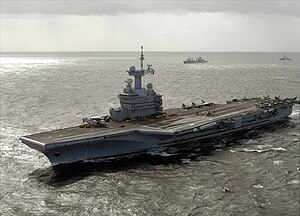Shokaku-class aircraft carrier
 FNS Shokaku on the Ceres Ocean in August 2019 | |
| Class overview | |
|---|---|
| Name: | Shokaku–class aircraft carrier |
| Builders: | Hitsubishi Heavy Industries |
| Operators: |
|
| Preceded by: | Mirai-class aircraft carrier |
| Succeeded by: | Kaga-class aircraft carrier |
| Cost: | $4.503 billion |
| In service: | 2009–present |
| In commission: | 2 |
| Planned: | 2 |
| Completed: | 2 |
| Active: | 2 |
| General characteristics | |
| Type: | Aircraft carrier |
| Tonnage: | 65,000 tonnes |
| Displacement: | About 71,650 short tons; 65,000 tonnes |
| Length: | 947 ft (289 m) |
| Beam: |
|
| Height: | 243 feet (74 m) |
| Draft: | 39 ft (12 m) |
| Installed power: | Two FA4M nuclear reactors |
| Propulsion: | Four shafts |
| Speed: | In excess of 32 knots (59 km/h; 37 mph) |
| Range: | Unlimited |
| Endurance: | 50-year service life |
| Complement: |
|
| Crew: | 2,000 |
| Armament: |
|
| Aircraft carried: | 60 |
| Aviation facilities: | 853 ft × 221 ft (260 m × 67 m) flight deck |
The Shokaku-class is a class of two nuclear-powered aircraft carriers in service with the Fuso Navy. Upon completion, the class was the largest ships built for the Fuso Navy since the decommissioning of the Mirai-class eighteen years ago. The Shokaku-class introduces unique designs and technologies inside that would meet the requirements of an effective, functioning carrier, as well as introducing a command-based ATECS system for operations management. It also has a unique aircraft launch system that reduces the stress on the body of the aircraft upon takeoff, as well as other designs that would improve the efficiency and reduce operating costs.
Both the Shokaku and Zuikaku carry up to 60 aircraft onboard. With a third of aircraft onboard comprised of FA-18C/D multirole fighter jets, and the rest either being complemented by combat/surveillance aircraft or helicopters. The launch of any aircraft onboard are done by an electromagnetic aircraft catapult launch system. For defensive capabilities, it is equipped with short to medium-range defensive weaponry for anti-aircraft warfare and missile defense. On January 23, 2018, a press leak confirmed the construction of the successor of the Shokaku-class, however, and on May 13, 2020, the government confirmed the completion of the Shokaku's larger successors, the Kaga-class.
Description
The Shokaku-class carriers have an overall length of 947 ft (289 m) and a full-load displacement of about 59,000 tonnes. They have a beam at the waterline of 134 ft (41 m), and the maximum width of their flight decks is 228 feet 10 inches (69.72 m) to 253 feet 3 inches. The ship's company can number up to a maximum of 2,800. Until the completion of the FNS Kaga, they are currently the largest warships in the Fusoese Navy.
The carriers armament and defenses are complemented by two anti-missile and anti-aircraft ESSM launchers, as well as four Phalanx CIWS. Some parts of the carriers are equipped with mounted anti-infantry weapons across with M2 Brownings. The carrier also carries one company-sized troops ready for offensive and defensive operations.
The Shokaku-class carriers can accommodate up to 60 aircraft of different types, but the Ministry suggests to carry 42 aircraft in order to accommodate for any aircraft to make a landing on the carriers itself, specifically in any emergency or other necessities. Five combat air squadrons, with each squadron having 6 FA-18s. A sixth and seventh squadron would either be composed of EFA-18s for electronic warfare operations, E-2 Hawkeyes for airborne early warning operations and other such, with the rest filled in by any aircraft such as a squadron of Anti-submarine helicopter squadrons that would compose of 5 to 6 SH-60s. The aircrew is also made up of support personnel involved in roles including maintenance, aircraft, and ordnance handling and emergency procedures. Each person on the flight deck wears color-coded clothing to make his role easily identifiable.
Ships in class
| Pennant no. | Ship | Commissioned | Status | Homeport | Notes | |||
|---|---|---|---|---|---|---|---|---|
| Shokaku subclass | ||||||||
| ACVN-01 | FNS Shokaku | 7 January 2009 | In service | Yokosa Naval Base, Yokosa City | Flagship of the Fuso Navy and the First Fleet (To be soon to the Third Fleet) | |||
| ACVN-02 | FNS Zuikaku | 18 October 2013 | In service | Kure Naval Base, Hanoshine City | Serves as the flagship of the Second Fleet | |||
Service history
2009–present
The first major operations in which the ships were involved as during airstrike and rescue missions in the Kaenai Peninsula during Operation Guardian Waves by Shokaku in February 2011, where she had deployed her airwing in providing additional strikes for coalition forces while rescuing stranded military troops during the Peninsula Wars. It later soon became a platform for major relief operations in the area upon its helicopter wing received about hundreds of civilians in need of medical attention, where she later transferred the majority of it's patients to the nearby Aventhian hospital ship Vincent. A year later, Shokaku was sent to the Fuso sea during a brief naval skirmish between North Khoshun and Fuso in the Changshun Straits, where it's airwing had sunk four gunboats and one corvette.